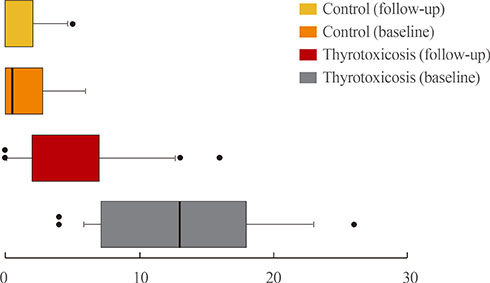Endocrinol Metab.
2018 Mar;33(1):70-78. 10.3803/EnM.2018.33.1.70.
Validity and Reliability of the Korean Version of the Hyperthyroidism Symptom Scale
- Affiliations
-
- 1Department of Internal Medicine, Seoul National University Healthcare System Gangnam Center, Seoul National University College of Medicine, Seoul, Korea.
- 2Department of Internal Medicine, Seoul National University Bundang Hospital, Seoul National University College of Medicine, Seongnam, Korea. jaemoon76@gmail.com
- 3Department of Internal Medicine, Seoul National University Hospital, Seoul National University College of Medicine, Seoul, Korea.
- KMID: 2407123
- DOI: http://doi.org/10.3803/EnM.2018.33.1.70
Abstract
- BACKGROUND
Thyrotoxicosis is a common disease resulting from an excess of thyroid hormones, which affects many organ systems. The clinical symptoms and signs are relatively nonspecific and can vary depending on age, sex, comorbidities, and the duration and cause of the disease. Several symptom rating scales have been developed in an attempt to assess these symptoms objectively and have been applied to diagnosis or to evaluation of the response to treatment. The aim of this study was to assess the reliability and validity of the Korean version of the hyperthyroidism symptom scale (K-HSS).
METHODS
Twenty-eight thyrotoxic patients and 10 healthy subjects completed the K-HSS at baseline and after follow-up at Seoul National University Bundang Hospital. The correlation between K-HSS scores and thyroid function was analyzed. K-HSS scores were compared between baseline and follow-up in patient and control groups. Cronbach's α coefficient was calculated to demonstrate the internal consistency of K-HSS.
RESULTS
The mean age of the participants was 34.7±9.8 years and 13 (34.2%) were men. K-HSS scores demonstrated a significant positive correlation with serum free thyroxine concentration and decreased significantly with improved thyroid function. K-HSS scores were highest in subclinically thyrotoxic subjects, lower in patients who were euthyroid after treatment, and lowest in the control group at follow-up, but these differences were not significant. Cronbach's α coefficient for the K-HSS was 0.86.
CONCLUSION
The K-HSS is a reliable and valid instrument for evaluating symptoms of thyrotoxicosis in Korean patients.
MeSH Terms
Figure
Reference
-
1. Devereaux D, Tewelde SZ. Hyperthyroidism and thyrotoxicosis. Emerg Med Clin North Am. 2014; 32:277–292.
Article2. De Leo S, Lee SY, Braverman LE. Hyperthyroidism. Lancet. 2016; 388:906–918.
Article3. Smith TJ, Hegedus L. Graves' disease. N Engl J Med. 2016; 375:1552–1565.
Article4. Boelaert K, Torlinska B, Holder RL, Franklyn JA. Older subjects with hyperthyroidism present with a paucity of symptoms and signs: a large cross-sectional study. J Clin Endocrinol Metab. 2010; 95:2715–2726.
Article5. Goichot B, Caron P, Landron F, Bouee S. Clinical presentation of hyperthyroidism in a large representative sample of outpatients in France: relationships with age, aetiology and hormonal parameters. Clin Endocrinol (Oxf). 2016; 84:445–451.
Article6. Larsen PR. Thyroid-pituitary interaction: feedback regulation of thyrotropin secretion by thyroid hormones. N Engl J Med. 1982; 306:23–32.7. Crooks J, Murray IP, Wayne EJ. Statistical methods applied to the clinical diagnosis of thyrotoxicosis. Q J Med. 1959; 28:211–234.8. Moura S, Almeida F, Nascimento F. Wayne's clinical index in the diagnosis of hyperthyroidism. Arq Bras Endocrinol Metabol. 1965; 14:41–46.9. Kalra S, Khandelwal SK, Goyal A. Clinical scoring scales in thyroidology: a compendium. Indian J Endocrinol Metab. 2011; 15:Suppl 2. S89–S94.
Article10. Klein I, Trzepacz PT, Roberts M, Levey GS. Symptom rating scale for assessing hyperthyroidism. Arch Intern Med. 1988; 148:387–390.
Article11. Ladenson PW, Singer PA, Ain KB, Bagchi N, Bigos ST, Levy EG, et al. American Thyroid Association guidelines for detection of thyroid dysfunction. Arch Intern Med. 2000; 160:1573–1575.
Article12. Geffner DL. Symptom rating scale for assessing hyperthyroidism. Arch Intern Med. 1989; 149:1466–1467.
Article13. Trzepacz PT, Klein I, Roberts M, Greenhouse J, Levey GS. Graves' disease: an analysis of thyroid hormone levels and hyperthyroid signs and symptoms. Am J Med. 1989; 87:558–561.
Article14. Kolawole BA, Ikem RT, Lawal OO. Relationship between thyroid hormone levels and hyperthyroid signs and symptoms. Niger J Clin Pract. 2002; 5:29–31.15. Cortina JM. What is coefficient alpha? An examination of theory and applications. J Appl Psychol. 1993; 78:98–104.
Article16. Bland JM, Altman DG. Cronbach's alpha. BMJ. 1997; 314:572.17. Tavakol M, Dennick R. Making sense of Cronbach's alpha. Int J Med Educ. 2011; 2:53–55.
Article18. O'Reilly DS. Thyroid function tests-time for a reassessment. BMJ. 2000; 320:1332–1334.19. Haugen BR, Alexander EK, Bible KC, Doherty GM, Mandel SJ, Nikiforov YE, et al. 2015 American Thyroid Association management guidelines for adult patients with thyroid nodules and differentiated thyroid cancer: the American Thyroid Association guidelines Task Force on thyroid nodules and differentiated thyroid cancer. Thyroid. 2016; 26:1–133.
- Full Text Links
- Actions
-
Cited
- CITED
-
- Close
- Share
- Similar articles
-
- Korean Version of the Revised UCLA Loneliness Scale: Reliability and Validity Test
- Reliability and Validity of the Korean Version of the Psychotic Symptom Rating Scale
- Reliability and Validity of Korean version of Diabetes Empowerment Scale Short Form
- Validity and Reliability of the Korean Version of Advance Directives Attitude Scale for Nurses
- Validation and Reliability of Korean Short Version of the Perspectives on Caring for Older Patients Scale



